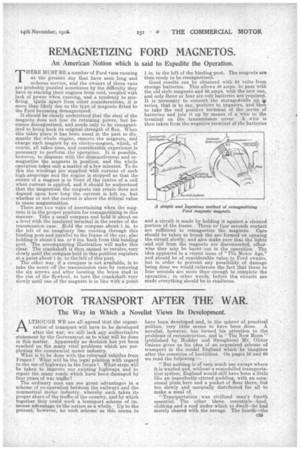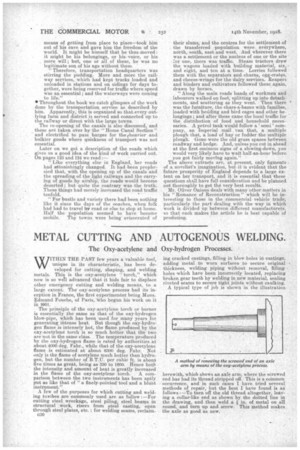MOTOR TRANSPORT AFTER THE WAR.
Page 9

Page 10

If you've noticed an error in this article please click here to report it so we can fix it.
The Way in Which a Novelist Views Its Development.
ALTHOUGH WE are all agreed that the organization of transport will have to be developed after the -war, we still lack any authoritative statement by the Government as to what -will be done in this matter. Apparently no decision has yet been reached on the many vital problems which are perplexing the commezcial motor industry. What is to be done with the returned vehicles from France? What will be the legal position -with regard to the use of highways in the future ? What steps will be taken to improve our existing highways and to repair the many roads which have been damaged by four years of war traffic?
The ordinary man can see great advantages in a scheme of co-operationbetween the railways and the commercial motor industry, whereby each takes its proper share of the traffic of the country, and by which together they could work a transport scheme of immense advantage to the nation as a whole. Up to the present, however, no such scheme as this seems to have been developed and, in the sphere of practical politics, very little seems to have been done. A novelist, however, has turned his attention to the problems of reconstruction, and in " The New Moon" (published •by Hodder and Stoughton) Mr. Oliver Onions gives us his idea of an organized scheme of transport in the model England which he imagines after the cessation of hostilities. On pages 59 and 60 we read the following :—
" But nothing is every .much use except where it is wanted and, without a remodelled transpertation system, England would still have been a. little like an imperfectly-stirred pudding, with an occasional plum, here and a pocket of flour there,. but too slowly andunequally distributed for all to make a meal of.
"Transportation was civilized man's fourth essential.' The other three essentials—food, clothing and a roof under which to dwell—he had merely shared with the savage. The fourth—the
means of getting from place to place—took him out of his cave and gave him the freedom of the -world. It might be himself that he thus-moved: it might be his belongings, or hisvoice, or his
, mere will; but, one or all of these, he was no legitimate son of his age without them.
"Therefore, transportation headquarters was stirring the pudding. More and more the railway services, whieli had kept trucks loaded and unloaded in stations and on sidings for days together, were being reserved for traffic where speed was an essential ; and the waterways were coining to life."
• Throughout the book we catch glimpses of the work done by the transportation service as described by him. Apparently, this is organized so that.every outlying farm and district is served and connected up to the railway or direct with the large towns. The re-opening of the canals is also discussed, and these are taken over by the "Home Canal Section" and electrified to pass barges for the (heavier and bulkier goods where quickness of transport was not essential.
Later on we get a description of the roads which gives us a good idea of the kind of work carried out. On pages 123 and 124 we read :
"Like Like everything else in England, her roads had attonishingly changed. It had been prophesied that, with the opening up of the canals and the spreading of the light railways and the carrying of goods by airship, the roads would become deserted; but quite the contrary was the truth. These things had merely increased the road traffic tenfold.
" For bustle and variety there had been nothing like it since the days of the coaches, when folk had had to travel by road or else to stop at home. Half the population seemed to have become Thp towns were being eviscerated of their shuns, and the centres for the settlement of the transferred population were everywhere, niarth,south, east and west. And wherever there was a settlement or the nucleus of one or the site for one, there was traffic. Steam tractors drew the wagons loaded with building material, six, and eight, and ten at a time. Lorries followed them with the separators and churns, egg-crates, and cheese-wrings for the dairy services. Reapers and binders and cultivators followed these again,
drawn by -horses. •
" Along the main roads bands of workmen and labourers walked on foot, splitting up into detach
ments, and scattering as they went. Then there ' was the furniture, the chars-a-banes with families, loaded with bedding and bird cages and other belongings ; and after these came the local traffic for the distribution of food and household necessaries. A petrol tank would follow a semi' company, an Imperial mail van that, a multiple plough that, a load of hay or fodder the multiple plough. Gone were the old grass spaces between roadway and hedge. And,-unless you cut in ahead at the first -ominous signs of a slowing-down, you would very likely have to wait half-an-hour before you got fairly moving again."
The above extracts are, at present, only figments • of a novelist's imagination, but it is evident that the future prosperity of England depends to a large extent on her transport, and it is essential that -these questions shall have full consideration and be planned out thoroughly to get the very best results. Mr. Oliver Onions deals with many other matters in his "Romance of Reconstruction" which will be interesting to those in the commercial vehicle trade, particularly the part dealing with the way in which work is divided up between different manufacturers. so that each makes the article he is best capable of producing.






















